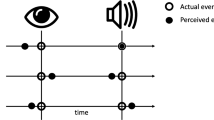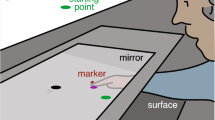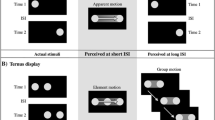Abstract
When we look at a clock with a hand showing seconds, the hand sometimes appears to stay longer at its first-seen position than at the following positions, evoking an illusion of chronostasis. This illusory extension of perceived duration has been shown to be coupled to saccadic eye movement and it has been suggested to serve as a mechanism of maintaining spatial stability across the saccade. Here, we examined the effects of three kinds of voluntary movements on the illusion of chonostasis: key press, voice command, and saccadic eye movement. We found that the illusion can occur with all three kinds of voluntary movements if such movements start the clock immediately. When a delay is introduced between the voluntary movement and the start of the clock, the delay itself is overestimated. These results indicate that the illusion of chronostasis is not specific to saccadic eye movement, and may therefore involve a more general mechanism of how voluntary action influences time perception.


Similar content being viewed by others
References
Blakemore S, Frith CD, Wolpert DM (1999) Spatio-temporal prediction modulates the perception of self-produced stimuli. J Cogn Neurosci 11:551–559
Haggard P (1999) Perceived timing of self-initiated action. In: Aschersleben G, Bachmann T, Müsseler J (eds) Cognitive contributions to the perception of spatial and temporal events. Elsevier, Amsterdam, pp 215–227
Haggard P, Clark S, Kalogeras J (2002) Voluntary action and conscious awareness. Nat Neurosci 5:382–385
Libet B, Gleason CA, Wright EW, Pearl DK (1983) Time of conscious intention to act in relation to onset of cerebral activity (readiness-potential): the unconscious initiation of a freely voluntary act. Brain 106:623–642
Miall C (2002) Stopping the clock. Trends Cogn Neurosci 6:66
Migliore M, Messineo L, Cardaci M, Ayala GF (2001) Quantitative modeling of perception and production of time intervals. J Neurophysiol 86:2754–2760
Rose D, Summers J (1995) Duration illusions in a train of visual stimuli. Perception 24:1177–1187
Thilo KV, Walsh V (2002) Vision: when the clock appears to stop. Curr Biol 12:R135–R137
Treisman M, Cook N, Naish PLN, MacCrone JK (1994) The internal clock: electroencephalographic evidence for oscillatory processes underlying time perception. Q J Exp Psychol A 47:241–289
Yarrow K, Haggard P, Heal R, Brown P, Rothwell JC (2001) Illusory perceptions of space and time preserve cross-saccadic perceptual continuity. Nature 414:302–305
Zakay D, Block RA (1996) The role of attention in time estimation processes. In: Pastor MA, Artieda J (eds) Time, internal clock, and movement. Elsevier, Amsterdam, pp 143–164
Acknowledgements
We thank R. Tang and K. Fong for their technical help. This research was supported by USPHS grant EY-05879.
Author information
Authors and Affiliations
Corresponding author
Rights and permissions
About this article
Cite this article
Park, J., Schlag-Rey, M. & Schlag, J. Voluntary action expands perceived duration of its sensory consequence. Exp Brain Res 149, 527–529 (2003). https://doi.org/10.1007/s00221-003-1376-x
Received:
Accepted:
Published:
Issue Date:
DOI: https://doi.org/10.1007/s00221-003-1376-x




